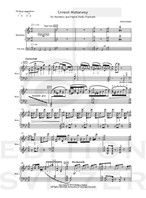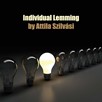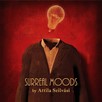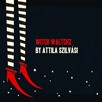
Unreal Motorway
Composer: Attila Szilvási
Instrument: Marimba and Tape
Level: unknown
Published: 2013
Price: €26.00
Item details
-
Description +
-
Unreal Motorway is a play inspired by science-fiction which sets the conversation of a narrator and a listener to music. The narrator tells stories about roads, vehicles, cities with a child’s devotion imagined by him, and finally about the experience of driving which the narrator and the listener transform together into real.
-
-
Instrumentation +
-
Marimba and Tape
-
-
Watch+
-
About the composer +
-
Attila Szilvási was born in 1982 in Budapest, Hungary. He started to play percussion at 10. In 1996 he was accepted to the Weiner Leó Secondary School of Music in Budapest where besides percussion he also studied composition. He was taught by Tibor Nemes, Lóránt Hajdú and Dénes Legány. He continued on his percussion studies at the Liszt Academy of Music in the faculty in Debrecen at István Szabó, he was granted master in percussion in 2006, in conducting in 2008. At present he is the principal percussionist at the Dohnányi Orchestra in Budapest, percussionist at the Budapest Concert Orchestra (MÁV). He played in almost all orchestras in Budapest and in several Symphonic Orchestras in Hungary.
During his studies he was a member of Talamba and SONUS percussion groups, where he got to know numerous inland and foreign contemporary compositions. At that time he also took part in several music competitions and was awarded the following: National University Percussion Solo Competition 2nd prize and special prize in 2002, 1st prize in 2003, International Marimba Competition in Belgium semifinalist in 2004.
He started to compose very early. His first pieces were mainly for piano, wind and percussion instruments, but lately he has concentrated on percussion, in particular on solo instrument pieces with electronic music accompaniment. In his master’s concert in 2006 his composition Gladiators of the Past and Future was played, which consists of two movements, composed for organ, percussion solo and synchronal-controlled electronic music accompaniment.
-
-
Reviews +
-
Percussive Notes, November 2016
An exciting medium that has grown exponentially in the last decade is percussion coupled with tape or recording. This piece is an interesting addition to this evolving library in that the soundscape provides more of a background accompaniment rather than a deliberate attempt to create a “second performer.” Oftentimes there are competing sounds or deliberate grooves into which the performer must fall, but not here. Attila Szilvasi created a track in which, although the tempo is audible, it’s not as immediately evident. This encourages the performer to supply the groove in the live portion of the performance, whether foundational, ethereal, or visceral.
As with all pieces with recordings, the tricky part is to line up with the pre-recorded track, and this piece is no different. There are multiple meter shifts, “irrational time signatures” (3/3, 3/6, and 3/12), and contemporary notation to keep the performer on his or her toes. The tracks (both practice and performance) are available via download from the publisher’s website, and the score gives very detailed instructions as to how to set up the sound equipment for optimal performance. Extended techniques such as playing on the edge of the bar with the shaft of the mallet (a la Keiko Abe’s “Wind in the Bamboo Grove”), resonator glisses, and rhythmic improvisation are present throughout the piece, which adds to the excitement, and creates another timbral treat for the performer and audience.
At 11 minutes long, this piece will work well for a seasoned performer, as stamina will be a factor in the effectiveness of this piece, making it appropriate for a degree recital or contemporary music concert.
—Marcus D. Reddick
-
-
Credits +
-
Front Cover graphics and layout: Attila Molnár
Engraving: Attila Szilvási
Foreword: Attila Szilvási
Printed in Copenhagen, Denmark
Copyright © Edition Svitzer
www.editionsvitzer.com
-







